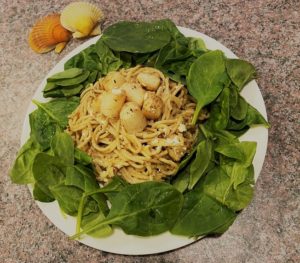Follow the guidance below to make sure your catch is safe to eat and as delicious as possible!
Safe Handling and Cooking
Ice down your catch. Place scallops on ice in a cooler until you clean them. Scallops will quickly die if left in the sun and will quickly spoil. Scallops will die quickly when placed on ice, especially if fresh water gets into their shells, but the cold temperature in the cooler keeps them from spoiling. Tip: store scallops by placing them on a wet towel on top of the ice in your cooler. This prevents meltwater from entering shells and can extend the amount of time scallops stay alive in the cooler, reducing bacterial growth.

Placing scallops on ice makes them easier to open, because the muscle holding the shells together relaxes. Drain the meltwater periodically and add more ice if needed to keep scallops cold until shucking.
Safe shucking. The video below shows you all you need to know about safe and easy scallop shucking. To shuck your scallops, grab either a shellfish knife (dull/blunt tip) or a teaspoon. The goal is to extract the circular white muscle meat, being careful to remove as much of the surrounding soft tissue as possible. Give a watch to the video for some tips on how to shuck your catch.
Cooking. Shellfish, such as oysters, that can be eaten raw are harvested from waters with very strict regulations. Scallops should be cooked because many open harvest areas for scallops are not subject to the same regulations. Food safety standards recommend that scallops should be cooked until the meat is opaque and white. This usually does not take long for bay scallops (about 3 minutes total in most cases), so be careful not to overcook.

Check out the links below for recipe ideas and a cooking demonstration of one of our most popular recipes: simply delish scallops.
- Simply Delish Scallops (cooking demonstration video) (recipe card pdf)
- Florida Citrus (Seared Scallops with Florida Grapefruit)
- Florida Sportfishing (Shrimp and Scallop Ceviche)
